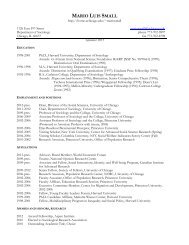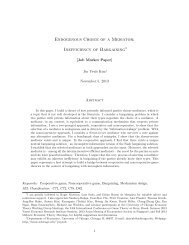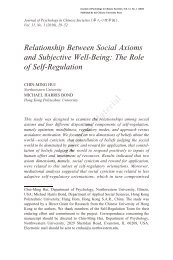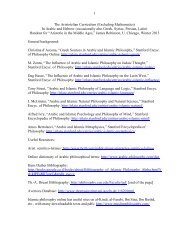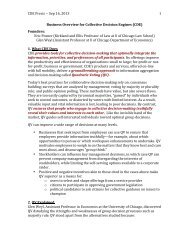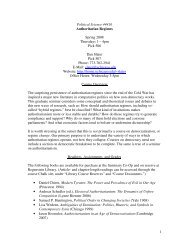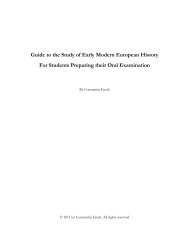Convergence Between Black Immigrants and Black Natives Across ...
Convergence Between Black Immigrants and Black Natives Across ...
Convergence Between Black Immigrants and Black Natives Across ...
You also want an ePaper? Increase the reach of your titles
YUMPU automatically turns print PDFs into web optimized ePapers that Google loves.
The Earning-Age of Immigration profile is more positively sloped for African <strong>and</strong> Caribbean blacks<br />
than those of other races. For Africans it is steeply upward sloping for both men <strong>and</strong> women. Both, African<br />
men <strong>and</strong> women on average have higher earnings premia than black Caribbeans. Refugees have a even<br />
steeper earnings-age of immigration profile than non-refugees, suggesting that deliberate location choice is<br />
not driving this pattern. Refugee men have exceptionally high return on their unobservables. This is in line<br />
with Cortes’s (2004) finding that from 1980 to 1990 refugees made greater gains in English proficiency,<br />
working hours, <strong>and</strong> wages, than economic immigrants.<br />
<strong>Black</strong> immigrants are much more likely than Asians <strong>and</strong> Hispanics to come from countries where English<br />
is an official language. This could lead to a decreased weight placed on arriving early. To explore this<br />
hypothesis, Figure 9e <strong>and</strong> Figure 9f split black immigrants into blacks who come from countries where<br />
English is an official language <strong>and</strong> those that do not. <strong>Immigrants</strong> from English speaking countries indeed<br />
have a less negatively sloped gradient for men <strong>and</strong> a more positively sloped gradient for women. <strong>Immigrants</strong><br />
from countries where English is not listed as an official language still have a considerably less negatively<br />
sloped earnings-age of immigration profile than Asians <strong>and</strong> Hispanics.<br />
6 The Importance of Labor Force Participation Differences<br />
6.1 <strong>Across</strong> Generation Comparison<br />
From Table 2 we already learned that labor force participation decisions differ significantly between blacks<br />
of the first <strong>and</strong> second generations. While 86% of black first generation males participate in the labor force,<br />
only 81% of age-adjusted second generation males are labor force participants. This difference does not<br />
exist for women where 76% of first generation females <strong>and</strong> 77% of second generation females participate in<br />
the labor force.<br />
Section 4 established that much of the convergence for women <strong>and</strong> all of it for men can be explained<br />
by differential labor force attachment propensities across generations. In order to underst<strong>and</strong> more about<br />
the convergence phenomenon, the subsequent regressions focus on labor force participation as an outcome<br />
variable.<br />
Table 7 <strong>and</strong> 8 focus on black men <strong>and</strong> women, respectively. In column (1) all immigrants are included.<br />
Columns (2) - (6) limit first generation immigrants to those who spent over 10 years in the US. This allows<br />
us to focus only on permanent immigrants; immigrants who are more likely to be parents of the subsequent<br />
second generation. We see that if all immigrants are included, the decrease in labor force participation is 10<br />
percentage points (.0806 - (-.0196)) for men. When recent immigrants are excluded, the decrease increases<br />
to close to 13 percentage points. Including state fixed effects shrinks the gap to about 11 percentage points.<br />
Column (5) restricts the sample to low-educated individuals (high school degree or less). For low-educated<br />
black men the decrease reaches 18 percentage points. This highlights the importance of differential labor<br />
force attachment for low-educated blacks across generations in explaining the convergence between black<br />
12



